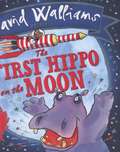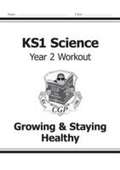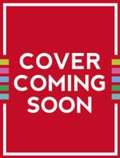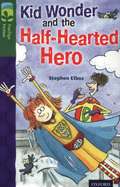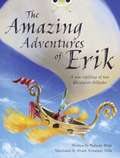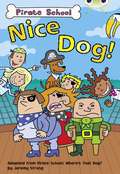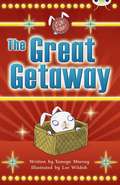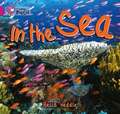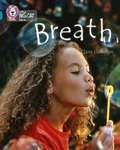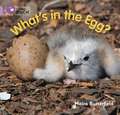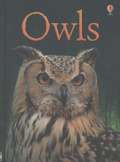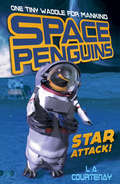- Table View
- List View
The First Hippo on the Moon (PDF)
by David WalliamsTwo big hippos. One enormous dream. Who can make it to the moon first?
KS1 Science Year Two Workout: Growing & Staying Healthy (PDF)
by Cgp BooksThis CGP Workout book is packed with practice covering everything Year 2 pupils (ages 6-7) need to know about Growing & Staying Healthy - all clearly laid out with plenty of space for writing answers. There’s a range of questions for each topic, with a mixed section at the end of the book that tests children on everything they’ve learned. Practical mini-projects are also included to help them develop their scientific investigation skills. Answers to every question are included on the pull-out centre pages, along with a useful A3 poster that pupils can colour in. CGP Year 2 Science Workout books are also available for: Habitats (9781782942344), Growing Plants (9781782942351) and Uses of Materials (9781782942375).
National Curriculum Maths: Practice Book for Year 1 (PDF)
by Lucy Tritton Kate Baxter Rachel Morgan Robin Hunt Lesley FletcherThis book can help your child by providing a whole year of ready to go activities and support on key Mathematics topics which will be being taught in school from 2014. Did you know that your child in Year 1 will now need to; count up 100 forwards and backwards from any given number; count in 2s, 5s and 10s; know maths facts up to 20? Workbooks for home learning. Linked directly to what your children will be learning in school. A linked website provides additional activities, answers and support for parents. Developed by teachers to ensure the best possible support for the new 2014 National Curriculum.
Oxford Reading Tree, TreeTops Fiction, Level 12 C: Kid Wonder and the Half Hearted Hero (2014 edition) (PDF)
by Stephen ElbozBook band 13 grey. Oxford level 12. In Kid Wonder and the Half-Hearted Hero Kid Wonder faces her toughest test yet. How can she get the hopeless superhero, Doughnut Boy, to take his job seriously? TreeTops Fiction is a series of funny, age-appropriate stories with wide appeal to both girls and boys. These motivating chapter books with engaging colour illustrations build stamina, fluency and comprehension across a rich range of vocabulary. Ideal for independent reading, the wide variety ensures there's something for every young student to enjoy, including humour, sci-fi, adventure, mystery and historical fiction. Levelled to provide clear and gradual progression with carefully controlled words per page. Written by leading children's authors who offer truly boy-friendly stories with gripping plots. treefic12c
Wordsmith Year 6 Eye of the Wolf (PDF)
by Daniel PennacThe wolf has lost nearly everything on his journey to the zoo, including an eye and his beloved pack. The boy too has lost much and seen many terrible things. They stand eye to eye on either side of the wolf's enclosure and, slowly, each makes his own extraordinary story known to the other...
Wordsmith Year 6 Salamander Dream (PDF)
by Hope LarsonOn summer afternoons, eight-year-old Hailey meets Salamander in the woods. They've been friends forever, and if she asks, sometimes he'll tell her a story...
Bug Club, Grey A/3A: The Amazing Adventures of Erik (PDF)
by Malachy DoylePart of the Bug Club whole school reading programme for Reception, KS1 and KS2 that transforms young readers into life-long readers. Children are instantly engaged by the characters they know and love and want to read more and more.
Bug Club, Lime B, Pirate School: Nice Dog! (PDF)
by Maureen Haselhurst Jeremy StrongPatagonia Clatterbottom is not happy. A dog has stowed away aboard her ship and inspectors have arrived to test her pupils on all their pirate skills. It's going to take morenbsp; than rope-climbing, plank-walking and cannon-fi ring to save the day - it's time for a mutiny! Ruff!
Bug Club, White B: The Great Getaway (PDF)
by Tamsyn MurrayMy name is Harriet Houdini, and I'm the kind of rabbit that amazing things happen to. First of all I became a TV star and then I was bunny-napped! Read on to find out how I made my great getaway!
Collins Big Cat, Band 01B/Pink B: In the Sea (PDF)
by Becca HeddleThis photographic non-fiction book explores the sea and looks at what kinds of plants and creatures live there - including fish, jellyfish, seaweed and seals! This photographic non-fiction book explores the sea and looks at what kinds of plants and creatures live there - including fish, jellyfish, seaweed and seals! Pink A/Band 1B books offer simple, predictable text with familiar objects and actions.
Collins Big Cat, Band 13, Topaz: Breath (PDF)
by Claire LlewellynEvery human has to breathe, but how do we do it - and why? This detailed non-fiction book clearly explains the breathing process, how your lungs are connected to the rest of your body, using detailed diagrams for support.
Collins Big Cat, Lilac, Band 0: What's in the Egg? (PDF)
by Moira ButterfieldThis photographic information book by Moira Butterfield shows the variety of creatures that hatch from eggs, including fish, turtles, crocodiles, seagulls and eagles. This photographic information book by Moira Butterfield shows the variety of creatures that hatch from eggs, including fish, turtles, crocodiles, seagulls and eagles. Lilac/Band 0 books are wordless books that have a narrative using pictures. A simple pictorial summary with labels on pages 14-15 provides an opportunity to recap and discuss the information in the book. Text type: A wordless information book Curriculum links: Understanding of the world
Fossil Finder (Collins Big Cat Progress Ser. (PDF))
by Lou Kuenzler Stephen Lee Collins StaffFollow the amazing true story of Mary Anning, a child from a poor family who sold seashells for a living and stumbled across a world of dinosaurs and fame. This fascinating story was written by Lou Kuenzler and illustrated in a graphic novel style. • Collins Big Cat Progress books are specifically designed for children at Key Stage 2 who have a Key Stage 1 reading level, giving them age-appropriate texts that they can read, building their confidence and fostering positive attitudes towards reading. • Text type: A graphic novel • Curriculum links: History • This book has been quizzed for Accelerated Reader.
Owls (PDF)
by Emily BoneThis book presents the reader with a large amount of information about owls, including different types of owls and how they live.
Space Penguins: Star Attack! (PDF)
by Lucy CourtenayWhen the crew of the Tunafish pick up a distress signal from a cargo craft, there's snow time to lose. But the Tunafish's daring rescue is canned when the vessel runs into trouble too. What's been luring spacecraft to their doom?
Alphabet- G to L (Large Print)
by RnibIn this series, there are two A5 images per A4 sheet. Cut each sheet along the fine vertical line down the centre to make two pages with an image on each. There will be a locator shown at the top left of each image when it is the correct way up. At the bottom right of each image, you will find its initial letter in lower and upper case braille and print characters.G is for grape - This image shows four grapes on a stem. The cut end of the grape's stem is at the top of the image. It branches out to the oval shapes of the sweet purple grapes further down the page.H is for hand - This is an image of a child's hand. The hand is seen from the back with its fingers in the top left of the page and thumb to the right. The wrist is in the bottom right of the page. Each finger and the thumb have a nail shown.I is for ice cream - This is a picture of a cool and delicious ice cream cone. At the top right of the picture is the pink strawberry ice cream. The cone with its patterned surface is further down the page. It tapers down to a point in the bottom left. J is for jug - This is an image of a pottery jug. The jug fills most of the page; its spout, where you pour out liquids, can be found at the top left of the image and the handle is on the right. The jug is pale yellow and has horizontal blue stripes.K is for key - This is an image of a key for a mortice lock. The grey metal key is in the middle of the page; its handle is at the top of the image. At the bottom of the image is the part of the key that you put in the lock to open it.L is for leaf - This is an image of a single green leaf from a tree. This is a leaf from a maple tree. It is in the middle of the page with its stalk to the right. On the main part of the leaf, its veins can be found branching out from the centre to the leaf.
Alphabet- G to L (UEB Contracted)
by RnibIn this series, there are two A5 images per A4 sheet. Cut each sheet along the fine vertical line down the centre to make two pages with an image on each. There will be a locator shown at the top left of each image when it is the correct way up. At the bottom right of each image, you will find its initial letter in lower and upper case braille and print characters.G is for grape - This image shows four grapes on a stem. The cut end of the grape's stem is at the top of the image. It branches out to the oval shapes of the sweet purple grapes further down the page.H is for hand - This is an image of a child's hand. The hand is seen from the back with its fingers in the top left of the page and thumb to the right. The wrist is in the bottom right of the page. Each finger and the thumb have a nail shown.I is for ice cream - This is a picture of a cool and delicious ice cream cone. At the top right of the picture is the pink strawberry ice cream. The cone with its patterned surface is further down the page. It tapers down to a point in the bottom left. J is for jug - This is an image of a pottery jug. The jug fills most of the page; its spout, where you pour out liquids, can be found at the top left of the image and the handle is on the right. The jug is pale yellow and has horizontal blue stripes.K is for key - This is an image of a key for a mortice lock. The grey metal key is in the middle of the page; its handle is at the top of the image. At the bottom of the image is the part of the key that you put in the lock to open it.L is for leaf - This is an image of a single green leaf from a tree. This is a leaf from a maple tree. It is in the middle of the page with its stalk to the right. On the main part of the leaf, its veins can be found branching out from the centre to the leaf.
Alphabet- G to L (UEB Uncontracted)
by RnibIn this series, there are two A5 images per A4 sheet. Cut each sheet along the fine vertical line down the centre to make two pages with an image on each. There will be a locator shown at the top left of each image when it is the correct way up. At the bottom right of each image, you will find its initial letter in lower and upper case braille and print characters.G is for grape - This image shows four grapes on a stem. The cut end of the grape's stem is at the top of the image. It branches out to the oval shapes of the sweet purple grapes further down the page.H is for hand - This is an image of a child's hand. The hand is seen from the back with its fingers in the top left of the page and thumb to the right. The wrist is in the bottom right of the page. Each finger and the thumb have a nail shown.I is for ice cream - This is a picture of a cool and delicious ice cream cone. At the top right of the picture is the pink strawberry ice cream. The cone with its patterned surface is further down the page. It tapers down to a point in the bottom left. J is for jug - This is an image of a pottery jug. The jug fills most of the page; its spout, where you pour out liquids, can be found at the top left of the image and the handle is on the right. The jug is pale yellow and has horizontal blue stripes.K is for key - This is an image of a key for a mortice lock. The grey metal key is in the middle of the page; its handle is at the top of the image. At the bottom of the image is the part of the key that you put in the lock to open it.L is for leaf - This is an image of a single green leaf from a tree. This is a leaf from a maple tree. It is in the middle of the page with its stalk to the right. On the main part of the leaf, its veins can be found branching out from the centre to the leaf.
Alphabet- M to R (Large Print)
by RnibIn this series, there are two A5 images per A4 sheet. Cut each sheet along the fine vertical line down the centre of the sheet, to give two pages with an image on each. There is a locator dot shown, which will be at the top left of the page when the image is the correct way up. At the bottom right of each image, you will find its initial letter in lower and upper case braille and print characters.M is for magnet - This image shows a magnet, a nail and a nut. The magnet is in the shape of a horseshoe; it is in the top left of the page and has two ends that curve down towards the centre of the page. The curved part of the magnet is painted red and the two ends are grey metal. The magnet attracts things that are made of iron. There is a nail stuck to the top end of the magnet and a six-sided metal nut stuck to the nail further down the page.N is for newt - This is a picture of a newt seen from the top. The dull green newt is a little amphibian creature; it lives in water and on land. Its head is on the centre left of the page with its body to the right. The newt's four legs can be found up and down from its body. Each of its feet has four toes. At the right of the image is the newt's long tapered tail.O is for owl - This is a picture of an owl seen from the side and facing right. The owl is in the centre of the page. Its head is in the top right of the page and it is turned to face you so that both its eyes and beak can be found. Down and to the left is the owl's body and folded wing. Its two legs are down from its wing and its tail feathers are to the bottom left.P is for pie - This is an image of an apple pie with a golden crust. It is seen form above. The round pie is in the centre of the page. A triangular slice has been cut out of the pie ready to eat, on the right of the page.Q is for queen - This is an image of a queen's head. The queen's head is in the middle of the page. She is facing you so that all the parts of her face can be found. At the top of the image is the queens golden crown, it is encrusted with red, green and blue jewels. Down from the crown the queenâ TMs face can be found. She has brown eyes with long lashes and long black hair, which covers her ears, to each side of her face.R is for ring - This is a picture of a ruby ring. The ring is seen from the side in the centre of the page. It has been shown about five times bigger than its actual size. The red ruby is at the top of the image. You can feel the way it has been cut to make it sparkle in the light. The circular ring curves down to the bottom part of the page.
Alphabet- M to R (UEB Contracted)
by RnibIn this series, there are two A5 images per A4 sheet. Cut each sheet along the fine vertical line down the centre of the sheet, to give two pages with an image on each. There is a locator dot shown, which will be at the top left of the page when the image is the correct way up. At the bottom right of each image, you will find its initial letter in lower and upper case braille and print characters.M is for magnet - This image shows a magnet, a nail and a nut. The magnet is in the shape of a horseshoe; it is in the top left of the page and has two ends that curve down towards the centre of the page. The curved part of the magnet is painted red and the two ends are grey metal. The magnet attracts things that are made of iron. There is a nail stuck to the top end of the magnet and a six-sided metal nut stuck to the nail further down the page.N is for newt - This is a picture of a newt seen from the top. The dull green newt is a little amphibian creature; it lives in water and on land. Its head is on the centre left of the page with its body to the right. The newt's four legs can be found up and down from its body. Each of its feet has four toes. At the right of the image is the newt's long tapered tail.O is for owl - This is a picture of an owl seen from the side and facing right. The owl is in the centre of the page. Its head is in the top right of the page and it is turned to face you so that both its eyes and beak can be found. Down and to the left is the owl's body and folded wing. Its two legs are down from its wing and its tail feathers are to the bottom left.P is for pie - This is an image of an apple pie with a golden crust. It is seen form above. The round pie is in the centre of the page. A triangular slice has been cut out of the pie ready to eat, on the right of the page.Q is for queen - This is an image of a queen's head. The queen's head is in the middle of the page. She is facing you so that all the parts of her face can be found. At the top of the image is the queens golden crown, it is encrusted with red, green and blue jewels. Down from the crown the queenâ TMs face can be found. She has brown eyes with long lashes and long black hair, which covers her ears, to each side of her face.R is for ring - This is a picture of a ruby ring. The ring is seen from the side in the centre of the page. It has been shown about five times bigger than its actual size. The red ruby is at the top of the image. You can feel the way it has been cut to make it sparkle in the light. The circular ring curves down to the bottom part of the page.
Alphabet- M to R (UEB Uncontracted)
by RnibIn this series, there are two A5 images per A4 sheet. Cut each sheet along the fine vertical line down the centre of the sheet, to give two pages with an image on each. There is a locator dot shown, which will be at the top left of the page when the image is the correct way up. At the bottom right of each image, you will find its initial letter in lower and upper case braille and print characters.M is for magnet - This image shows a magnet, a nail and a nut. The magnet is in the shape of a horseshoe; it is in the top left of the page and has two ends that curve down towards the centre of the page. The curved part of the magnet is painted red and the two ends are grey metal. The magnet attracts things that are made of iron. There is a nail stuck to the top end of the magnet and a six-sided metal nut stuck to the nail further down the page.N is for newt - This is a picture of a newt seen from the top. The dull green newt is a little amphibian creature; it lives in water and on land. Its head is on the centre left of the page with its body to the right. The newt's four legs can be found up and down from its body. Each of its feet has four toes. At the right of the image is the newt's long tapered tail.O is for owl - This is a picture of an owl seen from the side and facing right. The owl is in the centre of the page. Its head is in the top right of the page and it is turned to face you so that both its eyes and beak can be found. Down and to the left is the owl's body and folded wing. Its two legs are down from its wing and its tail feathers are to the bottom left.P is for pie - This is an image of an apple pie with a golden crust. It is seen form above. The round pie is in the centre of the page. A triangular slice has been cut out of the pie ready to eat, on the right of the page.Q is for queen - This is an image of a queen's head. The queen's head is in the middle of the page. She is facing you so that all the parts of her face can be found. At the top of the image is the queens golden crown, it is encrusted with red, green and blue jewels. Down from the crown the queenâ TMs face can be found. She has brown eyes with long lashes and long black hair, which covers her ears, to each side of her face.R is for ring - This is a picture of a ruby ring. The ring is seen from the side in the centre of the page. It has been shown about five times bigger than its actual size. The red ruby is at the top of the image. You can feel the way it has been cut to make it sparkle in the light. The circular ring curves down to the bottom part of the page.
Alphabet S to Z (Large Print)
by RnibIn this series, there are two A5 images per A4 sheet. Cut each sheet along the fine vertical line down the centre of the sheet, to give two pages with an image on each. There is a locator dot shown, which will be at the top left of the page when the image is the correct way up. At the bottom right of each image, you will find its initial letter in lower and upper case braille and print characters.S is for spoon - This is an image of a spoon. The spoon's grey stainless steel bowl is in the top right of the page. Down and to the left is the black plastic handle of the spoon. It has two round rivets to hold It onto the spoon's body.T is for triangle - This is a picture of a triangle, not the shape, but the musical instrument you might play in your school orchestra. At the top of the image is a green ribbon that you hold the triangle by; it is looped around the top corner of the triangle. The triangle is made from steel rod that has been bent into a three-sided shape. The triangle slopes down the page to the left and right. At the bottom of the triangle is the third side. At the bottom right of the page is the small rod that you use for striking the triangle to make a ringing sound.U is for umbrella - This is a picture of an umbrella seen from the side. The green canopy, (the fabric covering) of the umbrella is at the top right of the page, with the spiky end pointing towards the top. The umbrella's ribs curve down from the end with the fabric of the canopy arched between them at the bottom. The long tube of the umbrella goes down and left to the curved brown wooden handle at the bottom left of the page.V is for vase - This image shows a vase seen from the side with two flowers in it. At the top of the page there are two mauve coloured flowers facing you. Their green stems go down the page to the neck of the vase. The vase has a curved shape; it is coloured grey with a band of yellow, blue and pink decoration across its widest part.W is for watch - This is a picture of a watch seen from the front. Part of the watches brown leather strap is in the top right corner of the page. It has holes in it for size adjustment. Down and left is the watch face. It is seen from the front so all of the hands can be found. There is a long thick minute hand, a short thick hour hand and a long thin second hand. The small winding knob is on the right hand side of the watch face. Around the outside of the watche's face are small marks to show the hours. Further down and left is the rest of the strap and at the bottom left of the page is the small buckle for fastening the strap.X is for xylophone - This is an image of a toy xylophone: a type of musical instrument. The xylophone is in the middle of the page. It has bars of metal that you hit with the hammer at the bottom of the page to make a bell-like sound. There are eight differently coloured bars on this toy. Each one is fixed with two pins. The largest one is on the left of the page and makes the lowest note. The smallest is on the right and makes the highest note.Y is for yacht - This is an image of a toy yacht (sailing boat). The yacht is seen from the side and is facing to the left. At the top of the image is a tiny triangular red flag attached to the mast going down the page. To each side of the mast are the two triangular sails that catch the wind to move the boat. Further down the page is the boatâ TMs hull with a decorative stripe going across it and down again are the keel in the centre to steady the yacht, and the rudder on the right to steer it.Z is for zebra - This is a picture of a stripy zebra. The zebra is part of the horse family. This zebra is seen from the side and faces to the left. It is covered in mostly vertical black and white stripes. Its head is on the top left of the page and both of its ears can be found. To the right is the zebraâ TMs neck going down and right to its body. You can find its tail on the far right of the image and its four stripy legs down from its body.
Alphabet S to Z (UEB Contracted)
by RnibIn this series, there are two A5 images per A4 sheet. Cut each sheet along the fine vertical line down the centre of the sheet, to give two pages with an image on each. There is a locator dot shown, which will be at the top left of the page when the image is the correct way up. At the bottom right of each image, you will find its initial letter in lower and upper case braille and print characters.S is for spoon - This is an image of a spoon. The spoon's grey stainless steel bowl is in the top right of the page. Down and to the left is the black plastic handle of the spoon. It has two round rivets to hold It onto the spoon's body.T is for triangle - This is a picture of a triangle, not the shape, but the musical instrument you might play in your school orchestra. At the top of the image is a green ribbon that you hold the triangle by; it is looped around the top corner of the triangle. The triangle is made from steel rod that has been bent into a three-sided shape. The triangle slopes down the page to the left and right. At the bottom of the triangle is the third side. At the bottom right of the page is the small rod that you use for striking the triangle to make a ringing sound.U is for umbrella - This is a picture of an umbrella seen from the side. The green canopy, (the fabric covering) of the umbrella is at the top right of the page, with the spiky end pointing towards the top. The umbrella's ribs curve down from the end with the fabric of the canopy arched between them at the bottom. The long tube of the umbrella goes down and left to the curved brown wooden handle at the bottom left of the page.V is for vase - This image shows a vase seen from the side with two flowers in it. At the top of the page there are two mauve coloured flowers facing you. Their green stems go down the page to the neck of the vase. The vase has a curved shape; it is coloured grey with a band of yellow, blue and pink decoration across its widest part.W is for watch - This is a picture of a watch seen from the front. Part of the watches brown leather strap is in the top right corner of the page. It has holes in it for size adjustment. Down and left is the watch face. It is seen from the front so all of the hands can be found. There is a long thick minute hand, a short thick hour hand and a long thin second hand. The small winding knob is on the right hand side of the watch face. Around the outside of the watche's face are small marks to show the hours. Further down and left is the rest of the strap and at the bottom left of the page is the small buckle for fastening the strap.X is for xylophone - This is an image of a toy xylophone: a type of musical instrument. The xylophone is in the middle of the page. It has bars of metal that you hit with the hammer at the bottom of the page to make a bell-like sound. There are eight differently coloured bars on this toy. Each one is fixed with two pins. The largest one is on the left of the page and makes the lowest note. The smallest is on the right and makes the highest note.Y is for yacht - This is an image of a toy yacht (sailing boat). The yacht is seen from the side and is facing to the left. At the top of the image is a tiny triangular red flag attached to the mast going down the page. To each side of the mast are the two triangular sails that catch the wind to move the boat. Further down the page is the boatâ TMs hull with a decorative stripe going across it and down again are the keel in the centre to steady the yacht, and the rudder on the right to steer it.Z is for zebra - This is a picture of a stripy zebra. The zebra is part of the horse family. This zebra is seen from the side and faces to the left. It is covered in mostly vertical black and white stripes. Its head is on the top left of the page and both of its ears can be found. To the right is the zebraâ TMs neck going down and right to its body. You can find its tail on the far right of the image and its four stripy legs down from its body.
Alphabet S to Z (UEB Uncontracted)
by RnibIn this series, there are two A5 images per A4 sheet. Cut each sheet along the fine vertical line down the centre of the sheet, to give two pages with an image on each. There is a locator dot shown, which will be at the top left of the page when the image is the correct way up. At the bottom right of each image, you will find its initial letter in lower and upper case braille and print characters.S is for spoon - This is an image of a spoon. The spoon's grey stainless steel bowl is in the top right of the page. Down and to the left is the black plastic handle of the spoon. It has two round rivets to hold It onto the spoon's body.T is for triangle - This is a picture of a triangle, not the shape, but the musical instrument you might play in your school orchestra. At the top of the image is a green ribbon that you hold the triangle by; it is looped around the top corner of the triangle. The triangle is made from steel rod that has been bent into a three-sided shape. The triangle slopes down the page to the left and right. At the bottom of the triangle is the third side. At the bottom right of the page is the small rod that you use for striking the triangle to make a ringing sound.U is for umbrella - This is a picture of an umbrella seen from the side. The green canopy, (the fabric covering) of the umbrella is at the top right of the page, with the spiky end pointing towards the top. The umbrella's ribs curve down from the end with the fabric of the canopy arched between them at the bottom. The long tube of the umbrella goes down and left to the curved brown wooden handle at the bottom left of the page.V is for vase - This image shows a vase seen from the side with two flowers in it. At the top of the page there are two mauve coloured flowers facing you. Their green stems go down the page to the neck of the vase. The vase has a curved shape; it is coloured grey with a band of yellow, blue and pink decoration across its widest part.W is for watch - This is a picture of a watch seen from the front. Part of the watches brown leather strap is in the top right corner of the page. It has holes in it for size adjustment. Down and left is the watch face. It is seen from the front so all of the hands can be found. There is a long thick minute hand, a short thick hour hand and a long thin second hand. The small winding knob is on the right hand side of the watch face. Around the outside of the watche's face are small marks to show the hours. Further down and left is the rest of the strap and at the bottom left of the page is the small buckle for fastening the strap.X is for xylophone - This is an image of a toy xylophone: a type of musical instrument. The xylophone is in the middle of the page. It has bars of metal that you hit with the hammer at the bottom of the page to make a bell-like sound. There are eight differently coloured bars on this toy. Each one is fixed with two pins. The largest one is on the left of the page and makes the lowest note. The smallest is on the right and makes the highest note.Y is for yacht - This is an image of a toy yacht (sailing boat). The yacht is seen from the side and is facing to the left. At the top of the image is a tiny triangular red flag attached to the mast going down the page. To each side of the mast are the two triangular sails that catch the wind to move the boat. Further down the page is the boatâ TMs hull with a decorative stripe going across it and down again are the keel in the centre to steady the yacht, and the rudder on the right to steer it.Z is for zebra - This is a picture of a stripy zebra. The zebra is part of the horse family. This zebra is seen from the side and faces to the left. It is covered in mostly vertical black and white stripes. Its head is on the top left of the page and both of its ears can be found. To the right is the zebraâ TMs neck going down and right to its body. You can find its tail on the far right of the image and its four stripy legs down from its body.
Alphabet- A to F (Large Print)
by RnibIn this series, there are two A5 images per A4 sheet. Cut each sheet along the fine vertical line down the centre to make two pages with an image on each. There will be a locator shown at the top left of each image when it is the correct way up. At the bottom right of each image, you will find its initial letter in lower and upper case braille and print characters.A is for apple - here is a juicy red and green apple on this page. The apple is seen from the side in the middle of the page. Its stalk is at the top of the image and down the page is the fleshy fruit. At the bottom centre of the image are the calyx and stamen. These are the remaining parts of the flower that the apple has grown from.B is for Ball: This is an image of a bouncy toy ball. The round ball is in the centre of the page. It is blue and is decorated with yellow spots.C is for cat - This is an image of a furry cats head. The cats head is seen from the front so that you can see all the parts of its face. You can find some of the cat's long hair on either side of its ears at the top of the image. Down the page are the cat's two eyes looking straight at you and further down is its nose and mouth. The cat has very long whiskers sticking out to the left and right; these help the cat feel its way through narrow spaces.D is for doll - This is a picture of a pretty rag doll. The doll is facing you in the middle of the page so that you can see all the parts of her face. Her head is at the top of the image. She has yellow hair styled in pigtails that stick out to the left and right. She has two big eyes, a little button nose and a big smiley mouth. Down the page is the doll's body. She is wearing an orange t-shirt and a blue pinafore dress. She has her arms stretched out to each side. Further down the page she is wearing blue and yellow stripy stockings on her legs and green shoes on her feet at the bottom of the page.E is for egg - This is an image of a decorated Easter egg. The egg is in the centre of the page. It is pointier at the top of the image and rounder at the bottom. The egg has been painted blue and has a pink band of decoration with yellow stars and circles across its middle.F is for feather - This is an image of a blue feather. The feather is in the centre of the page. Its shaft curves left then right down the centre of the image to the bottom of the page. You can find the featherâ TMs barbs to the left and right of the shaft.
